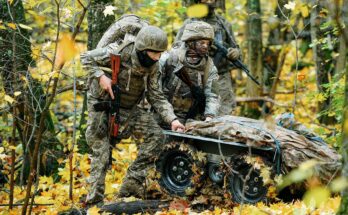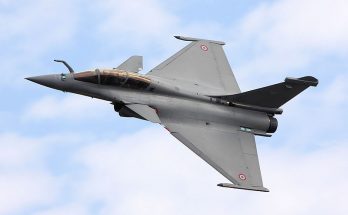
On June 13, 2023, the Russian Ministry of Defense released a short video clip purporting to show battle-damaged Leopard 2 main battle tanks and Bradley Fighting Vehicles captured by Russian forces. In a statement released with the clip, the Russian MoD asserted, “Leopard tanks and Bradley infantry fighting vehicles. These are our trophies. Equipment of the Ukrainian armed forces in the Zaporizhzhia region. Servicemen of the Vostok group inspect enemy tanks and infantry fighting vehicles captured in battle.”
Open-source reporting confirms the Ukrainians lost one Leopard 2A6 from their 33rd Mechanized Brigade, possibly nine M2A2 Bradley Fighting Vehicles from their 47th Assault Brigade, and one BMR-2 mine-clearing vehicle in a failed attempt to breach a minefield south of Mala Tokmachka on June 8, 2023.
Reports indicate the Ukrainians have lost sixteen Bradley Fighting Vehicles in action since April — 5 reportedly destroyed and 11 damaged and abandoned.
On January 5, 2023, the U.S. Department of Defense announced it would transfer Bradley Fighting Vehicles to Ukraine. The consignment would ultimately consist of 109 M2A2 ODS Bradleys and 4 M7 BFIST Bradley fire support vehicles. In February 2023, the U.S. Army reportedly began training Ukrainian troops to operate and maintain the Bradleys at the Grafenwöhr Training Area in Germany.
On January 25, 2023, the German government announced it would initially transfer 14 Leopard 2 tanks to Ukraine and allow other NATO allies to likewise transfer Leopard 2s to Ukraine. This announcement represented the conclusion of months of wrangling between NATO members over the transfer of high-end main battle tanks to Ukraine.
On March 27, 2023, the German Federal Ministry of Defence announced the formal transfer of 18 Leopard 2A6 tanks (an increase of 4 tanks over the original pledge) at the Ukraine border. Portugal is contributing three Leopard 2A6 tanks and Sweden 10. Poland has supplied Ukraine with a battalion of Leopard 2 A4 tanks. Spain is contributing another 6 Leopard 2A4s.
Since February, Ukrainian tank crews have reportedly been training on the Leopard 2A6 at the Bundeswehr facility in Münster, in Lower Saxony.
On April 14, 2023, the Canadian Defense Minister announced Canada has completed delivery of 8 Leopard 2A4 tanks to Poland, for transfer to Ukraine.
While many defense pundits wax eloquently about the technological sophistication of Western combat vehicles, the Forecast International Weapons Group once again maintains technology alone is not the key to modern armored warfare. How these tanks are employed tactically is, and always will be, the key factor. And so, we must look beyond technology to tactical doctrine, training and employment.
In terms of tactical doctrine and training, the Russian and Ukrainian Armies are branches of the same tree, inheritors of the same Soviet Red Army heritage. As such, their common doctrine for tank warfare was shaped by the pioneering tactics of Marshal Georgy Konstantinovich Zhukov. Zhukov’s doctrine employed tank forces as a monolithic mobile sledgehammer — Hey, diddle diddle, straight up the middle. Smash anything in your way. Russian tank design reflects this tactical philosophy.
Western tank tactical doctrine, on the other hand, is grounded in a cavalry-based philosophy — Move fast, strike hard. Don’t give the enemy a chance to effectively react. Where the Russians look to Zhukov for inspiration, the Western armies look to Heinz Guderian, Erwin Rommel, and that most magnificent cavalryman of all, George S. Patton. Western tank design reflects this tactical philosophy, with its emphasis on the speed and maneuverability of the platform, combined with the situational awareness and tactical initiative of the crew.
In Ukraine, if Western combat vehicles are employed with crews and commanders well-grounded in Western armored warfare doctrine, the impact on the battlefield will be devastating for Russian forces. But if Ukrainian forces try to employ these Western tanks and infantry fighting vehicles according to their existing Soviet-style doctrine, the results on the battlefield will be mixed at best, disastrous at worst.
Ukrainian personnel must be trained to operate, maintain and effectively employ these tanks. That level of training simply does not happen overnight. Even the most sophisticated weapon in the world is utterly useless in untrained (or poorly trained) hands.
Sadly, photographic evidence of the June 8th action south of Mala Tokmachka indicates the Ukrainians have NOT embraced Western armored combat doctrine yet. Indeed, the evidence indicates the Ukrainians are still operating in the same discredited Russian mode. They persist — like their Russian adversaries — in failing to properly disperse their assets (bunching up), failing to properly maneuver their assets (attempting to cross uncleared minefields), and then abandoning those damaged assets on the field without even attempting to destroy sensitive items. All three failures clearly indicate a serious lack of proper training and motivation.
Technology does not win battles. Properly trained soldiers win battles. To ignore that enduring reality is to invite disaster and defeat.
Dean is responsible for Military Vehicles Forecast and Ordnance & Munitions Forecast. Prior to joining Forecast International, Dean served as an intelligence analyst in the U.S. Army for 10 years. As an Order of Battle and weapons specialist, he served in a variety of assignments, ranging from running the intelligence section of an Apache attack helicopter squadron in combat to representing a theater-level intelligence organization in a national-level interagency intelligence working group. His intelligence assignments have included duty in Japan, Korea, the Netherlands, Germany, Turkey and Iraq, as well as Fort Hood, Texas, and Norfolk, Virginia.




